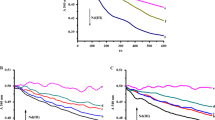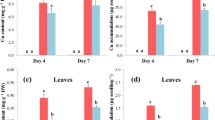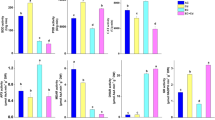Abstract
The effect of cerium on mitochondria isolated from hybrid rice Shanyou 63 (Oryza sativa L) was investigated. Through in vivo culture, low dose Ce3+ promoted, but higher dose Ce3+, restrained mitochondrial heat production. However, through vitro incubation, Ce3+ showed only inhibitory action on mitochondrial energy turnover, the concentration required for 50% inhibition being 46.7 μM. In addition, Ce3+, like Ca2+, induced rice mitochondrial swelling and decreased membrane potential (△ψ), which was inhibited by the specific permeability transition inhibitor cyclosporine A (CsA). The induction approached a constant level while mitochondrial metabolism was fully prevented by Ce3+. These results demonstrated that cerium influenced rice mitochondria in vivo and in vitro via different action pathways, and the latter involved the opening of rice mitochondrial permeability.
Similar content being viewed by others

Avoid common mistakes on your manuscript.
Introduction
Mitochondria play a central role in energy metabolism within the cell. Isolated mitochondria still perform some metabolic processes, such as tricarboxylic acid oxidation and fatty acid β-oxidation in the presence of oxygen [1]. If the heat production of isolated mitochondria is monitored by calorimetry, much useful information, both qualitative and quantitative, may be obtained [2–6].
Early in 1940s, it was found that lanthanides can be used to facilitate plant growth, especially in enhancement of plant root and germination, increment of chlorophyll content and reinforcement of photosynthesis and nutrients absorption. Many studies demonstrated that because of their similarity to calcium regarding ionic radii, coordination chemistry, and preference for oxygen donor groups; lanthanides exerted similar biological and physiological effects on organisms, in particular enhancement of plant growth [7, 8]. Mitochondria play a crucial role in respiration and metabolism [9]; however, to date, little is known about the mechanism by which lanthanides act at the mitochondria level in plant cells. In addition, lanthanides have been shown to promote apoptosis in mammal cells by inducing mitochondrial permeability [10, 11]. For these reasons, we first determined the effects of Ce3+ on the heat production of hybrid rice Shanyou 63 mitochondria both in vivo and in vitro, and then we examined whether Ce3+ induced rice mitochondrial permeability in vitro. The selected hybrid rice (Shanyou 63) has been widely cultured in China because of its high yield, good grain quality, resistance to bacterial leaf blight, and wide adaptability.
Experiment
Materials
Hybrid rice Shanyou 63 was supplied by College of Life Sciences, Wuhan University, and CeCl3 (A.R.) was purchased from Shanghai Reagent Co. Ltd. and dissolved in deionized water. CsA, rotenone, rhodamine 123 (Rh 123), Na2ADP, and Na pyruvate were purchased from Sigma.
Plant Culture
Rice Shanyou 63 was grown in incubators without sunlight. Firstly, rice seeds were sterilized by H2O2 (10%) for 30 min and washed with deionized water. Then, they were germinated in deionized water overnight and transferred into plastic trays containing deionized water or designed concentration CeCl3 solution. The water or CeCl3 solution was changed twice daily, and the temperature was 25–28°C during growth. Once the etiolated seedlings grew to 6–7 cm long, they would be cut as experimental materials.
Isolation of Mitochondria
The etiolated seedlings were rinsed in cold sterilized isolation medium A consisting of 400 mM sucrose, 50 mM Tris, 1 mM EDTA, 5 mM KCl, 0.1% (w/v) BSA, pH 7.4, and minced, homogenized, and centrifuged at 900×g for 10 min. The supernatant was centrifuged at 2,000×g for 8 min and then 10,000×g for 15 min in a new tube. The pellets were suspended in isolation buffer B consisting of 400 mM sucrose, 20 mM Tris, 1 mM HEPES, pH 7.4. The later gradient centrifugation was implemented as described by Luo et al. [12] with modification. Briefly, the supernatant was layered onto a previously poured, 12% (v/v) Percoll, 26% Percoll, 40% Percoll density gradient which consisted of 250 mM sucrose, 5 mM HEPES, and 0.1% BSA, pH 7.2. The suspension/gradient was centrifuged at 40,000×g for 40 min. The mitochondria were removed from the brownish band at 1.10 g/mL with a transfer pipette. Mitochondrial pellets were washed with buffer B by centrifuging for 10 min at 6,300×g. The purified mitochondrion were resuspended in buffer B to a given protein concentration. All the above operations were performed aseptically at 0–4°C. Mitochondria protein concentration was determined by biuret method.
Calorimetry Determination
The heat flux of mitochondria metabolism was determined with a 3114/3236 TAM air isothermal calorimeter (Thermometric AB, Sweden) using the ampoule method at 28°C. The sensitivity (precision) of this calorimeter is ±10 μW. Baselines were taken before each measurement, and the calorimeter was calibrated electrically. Details of the instrument can be found in Ref. [13]. One sealed ampoule contained isolation buffer; the other contained the sample (4.0 mg/mL mitochondria suspension plus or minus CeCl3). Each ampoule had 1.0 mL sample or reference and ~25.0 mL of air, which provided basically sufficient oxygen for mitochondria metabolism.
Measurement of Mitochondrial Swelling and Membrane Potential (△ψ)
The swelling of mitochondria was monitored as the decrease in the absorbance at 540 nm in studies with Ce3+ and Ca2+, in a spectrophotometer, Shimadzu UV-3,000. Mitochondria (1.0 mg/mL) was suspended in 3 mL buffer (300 mM sucrose, 10 mM HEPES, 5 mM KH2PO4, pH 7.2). Pyruvate (8 mM) was used as the energizing substrate to induce swelling. The relative swelling rate was defined as: swelling rate = ∆A of sample/∆A of control [10]. For membrane potential measurement experiments, mitochondria (1.0 mg/mL) was incubated at 25°C in buffer C containing 300 mM sucrose, 10 mM HEPES, 5 mM KH2PO4, 8 mM pyruvate, and 1 μg/mL rotenone. The △ψ was assessed spectrophotometrically (Hitachi F-2,500) by Rh 123 uptake with excitation at 505 nm and recording at 530 nm after addition of 1 μM Rh 123.
Depending on these experiments, mitochondria were pre-incubated with 1 μM CsA.
Results
Heat Rate from Mitochondrial Metabolism Isolated from Hybrid Rice Shanyou 63
The heat production rate from freshly isolated rice mitochondria is shown in Fig. 1. Pyruvate, the substrate of tricarboxylic acid cycle, accelerated the mitochondrial heat production and increased the maximum heat rate, suggesting that tricarboxylic acid cycle was promoted by the substrate. This station is defined as mitochondrial metabolism baseline [2]. Addition of phosphate acceptor ADP or uncoupling agent DNP to the mitochondria also accelerated their energy expenditure and greatly increased heat rate, which further demonstrated that respiration of isolated mitochondria was coupled with phosphorylation to carry out ADP/ATP translation.
The heat production rate of freshly prepared mitochondria from rice was promoted by mitochondrial substrate pyruvate, phosphate acceptor ADP, or an uncoupling agent DNP. The heat production of 1.0 mL buffer B (a) and mitochondria (4.0 mg protein/mL) (b) were measured as the control, and 20 mM pyruvate (c), 2 mM ADP (d), or 50 μM DNP (e) were respectively added to mitochondria to test mitochondrial metabolic activity. The results were typical of three independent experiments
Effect of Ce3+ on Heat Production of Rice Mitochondria In Vivo and In Vitro
Lanthanides are known to facilitate plant growth; our preliminary experiment for rice culture with CeCl3 solution agreed with that. CeCl3 solution ranging from 1.4 to 14.0 mg/L remarkably increased biomass of the rice-etiolated seedlings, but 21.0 mg/L CeCl3 showed a negative effect (data not shown). To further elucidate action mechanism of Ce3+ on plant growth, the effect of CeCl3 on heat production of rice mitochondria (mitochondria suspension plus 20 mM pyruvate) in vivo was determined (Fig. 2a). Application of CeCl3 did not induce significant change in mitochondrial maximum heat rate, but the heat production was accelerated by 1.4–14.0 mg/L CeCl3 with the curtailment of mitochondrial activity recovery phase and restrained by 21.0 mg/L CeCl3 with the delay of activity recovery phase. This result, combined with our preliminary experiment, indicated that the beneficial effect of Ce3+ on rice growth may be due to its stimulating action on mitochondrial metabolism via vivo pathway.
Effect of Ce3+ on metabolism activity of rice mitochondria in vivo (a) and in vitro (b). In vivo treatment, the rice seeds were cultivated with CeCl3 solution, and mitochondrial heat production of etiolated seedlings was measured as described in the “Experiment” section. The concentrations 0, 1.4, 7.0, 14.0, and 21.0 mg/L were corresponding to the curves signed with a, b, c, d, e, respectively. In vitro treatment (b), 0, 3.6, 14.4, 28.8, 57.6 μM CeCl3 were added to mitochondria suspension, and the calorimetric results were shown in curves a, b, c, d, and e. All results were respectively examples of three independent experiments. The plot (c) further elucidated the concentration-dependent inhibition of CeCl3 on the maximum heat rate of rice mitochondria in vitro treatment
In contrast, application of CeCl3 to rice mitochondria in vitro lead to inhibitory effect on mitochondrial heat production (Fig. 2b, c). The plot (c) elucidated linear dose-dependent inhibition of CeCl3 on the maximum heat rate of rice mitochondria. The correlation coefficients of plot (c) reached 0.9986, and IC50 (inhibition concentration for 50% of maximum heat rate of rice mitochondria) of Ce3+ was 46.7 μM.
Effects of Ce3+ on Mitochondrial Swelling and Membrane Potential (△ψ)
Liu et al. reported that lanthanide, like Ca2+, induced mitochondrial permeability transition in mammal cells, which triggered the apoptotic procedure [10]. So, we investigated the effects of Ce3+ and Ca2+ on rice mitochondrial swelling (Fig. 3) and membrane potential (△ψ) (Fig. 4). Ce3+ (50.0 μM) and 50.0 μM Ca2+ induced rice mitochondrial swelling (Fig. 3a). The same concentrations of Ce3+ and Ca2+ induced △ψ loss. The induction of Ce3+ on △ψ loss was blocked by 1 μM CsA completely (Fig. 4). These results indicated that Ce3+ increased mitochondrial permeability.
Induction of rice mitochondrial (1.0 mg/mL) swelling by Ce3+ and Ca2+. Change in the optical absorbance at 540 nm was recorded as described in the “Experiment” section. The time-dependent decrease of the absorption of mitochondria upon incubation with 50.0 μM Ce3+ and Ca2+ in the presence of 8 mM pyruvate was shown in a. The dose-dependent effect of Ce3+ on mitochondrial swelling rate was shown in b
Rice mitochondria (1.0 mg/mL) were incubated with Ce3+, Ca2+, or 1 μM cyclosporin A, and induction of △ψ was assessed by measuring the △ψ-dependent uptake of Rh 123 as described in the “Experiment” section. The Rh 123 intensity of buffer C (a) and mitochondria without further treatment (b), treated with 50.0 μM Ca2+ (c) and treated with 50.0 μM Ce3+ (d) were shown in a. The dose-dependent effect of Ce3+ and CsA inhibition on △ψ loss were shown in b. The Rh 123 intensity of mitochondria (a), mitochondria treated with Ce3+ of 5.0 μM (b), 10.0 μM (c), 25.0 μM (d), 50.0 μM (e), 80.0 μM (f), 100.0 μM (g), and mitochondria treated with CsA before treatment with 50.0 μM Ce3+ (h) were shown
Mitochondrial swelling and membrane potential △ψ loss caused by Ce3+ increased with increase in Ce3+ from 5.0 to 50.0 μM, but it tended to level when Ce3+ exceeded 50.0 μM. The fluorescent intensity of mitochondria treated with 50.0 μM Ce3+ approached Rh 123 intensity of isolated medium (Fig. 4), indicating that mitochondrial membrane permeability in this state was nearly whole open. So, further increase in concentration of the cation did not induce any change in mitochondrial permeability.
Discussion
We investigated the effects of cerium, a beneficial element to plants, on rice mitochondrial heat production in vivo and in vitro. The in vivo results demonstrated that Ce3+ at low dose accelerated mitochondrial metabolism, but high dose restrained it. Many studies showed that rice grown in solution culture accumulated some concentrations of lanthanides in root and stem [14], and very low concentrations of lanthanides could pass through plant cell wall with the help of carriers such as protein, hormone, etc., and even enter into cell organelles via certain cation channels [15, 16]. Since lanthanides could replace Ca2+, Cu2+, or Mg2+ in enzymes to facilitate enzymatic activity [7, 17], the mitochondrial metabolism of rice cultured with proper concentration of lanthanides would be promoted. Considering the vital role of mitochondria in plant respiration and metabolism, seed germination and rice growth would be enhanced by lanthanides. The present study offered a new pathway to understand action mechanism of lanthanides on plant growth.
In contrast, the in vitro incubation of Ce3+ resulted in progressive decrease in heat rate of rice mitochondria. As many transition metals including lanthanides, like Ca2+, increased mitochondrial permeability and promoted apoptosis in mammal cells [10, 18–20], we further examined whether Ce3+ increased permeability of rice mitochondria. The results demonstrated that Ce3+ and Ca2+ did induce mitochondrial swelling and decreased mitochondrial potential (△ψ), and the induction ability of Ce3+ was stronger than that of Ca2+ (Figs. 3 and 4). The mechanism by which excess Ca2+ induced mitochondrial permeability was much less clear. The conventional hypothesis was that calcium overload leads to the generation of reactive oxygen species (ROS), and calcium overload resulted from excess stimulation of NMDA receptors by glutamine [21]. Lanthanide ions, as analogy to calcium, were reported to produce ROS in mitochondria [10, 20], which may be the reason why Ce3+ induced mitochondrial permeability. As Ce3+ had similar ion radii to Ca2+, its relevant high covalence may make it have greater induction ability than Ca2+.
References
Myers DK, Slater EC (1957) The enzymic hydrolysis of adenosine triphosphate by liver mitochondria. 2. Effect of inhibitors and added cofactors. Biochem J 67:572–579
Köhnke D, Schramm M, Daut J (1997) Oxidative phosphorylation in myocardial mitochondria ‘in situ’: a calorimetric study on permeabilized cardiac muscle preparations. Mol Cell Biochem 74:101–113
Nedergaard J, Canno B, Lindberg O (1977) Microcalorimetry of isolated mammalian cells. Nature 267:518–520
Liu Y, Deng FJ, Zhao RM, Shen XS, Wang CX (2000) Microcalorimetric studies of the toxic action of La3+ in mitochondria isolated from Star-cross 288 chicken heart tissue cells. Chemosphere 40:851–854
Dai J, Li CL, Zhang YZ, Xiao Q, Lei KL, Liu Y (2008) Effect of La3+ on heat production by mitochondria isolated from hybrid rice. Thermochim Acta 470:77–82
Dai J, Li CL, Zhang YZ, Xiao Q, Lei KL, Liu Y (2008) Bioenergetic investigation of the effects of La(III)and Ca(II)on metabolic activity of Tetrahymena thermophila BF5. Biol Trace Elem Res 122:148–156
Hu Z, Richter H, Sparovek G, Schnug E (2004) Physiological and biochemical effects of rare earth elements on plants and their agricultural significance: a review. J Plant Nutr 27:183–220
Liu XQ, Huang H, Liu C, Zhou M, Hong FS (2009) Physico-chemical property of rare earths-effects on the energy regulation of photosystem II in Arabidopsis thaliana. Biol Trace Elem Res 130:141–151
Scott I, Logan DC (2008) Mitochondria and cell death programmes in plants—actions speak louder than words. Plant Signal Behav 3:475–477
Liu HX, Yuan L, Yang XD, Wang K (2003) La3+, Gd3+ and Yb3+ induced changes in mitochondrial structure, membrane permeability, cytochrome C release and intracellular ROS level. Chem Biol Interact 146:27–37
Greisberg JK, Wolf JM, Wyman J, Zou L, Terek RM (2001) Gadolinium inhibits thymidine incorporation and induces apoptosis in chondrocytes. J Orthop Res 19:797–801
Cipolat S, Rudka T, Hartmann D, Costa V, Serneels L, Craessaerts K, Metzger K, Frezza C, Annaert W, D’Adamio L, Derks C, Dejaegere T, Pellegrini L, D’Hooge R, Scorrano L, De Strooper B (2006) Mitochondrial rhomboid PARLregulates cytochrome C release during apoptosis via OPA1-dependent cristae remodeling. Cell 126:163–175
Wadsö I (2002) Isothermal microcalorimetry in applied biology. Thermochim Acta 394:305–311
Hong FS, Wang L, Meng XX, Wei Z, Zhao GW (2002) The effect of cerium (III) on the chlorophyll formation in spinach. Biol Trace Elem Res 89:263–276
Tagami K, Uchida S (2006) Transfer of REEs from nutrient solution to radish through fine roots and their distribution in the plant. J Alloy Compd 408–412:409–412
Lai Y, Wang QQ, Yang LM, Huang BL (2006) Subcellular distribution of rare earth elements and characterization of their binding species in a newly discovered hyperaccumulator Pronephrium simplex. Talanta 70:26–31
Tyler G (2004) Rare earth elements in soil and plant systems—a review. Plant Soil 267:191–206
Yamada A, Yamamoto T, Yamazaki N, Yamashita K, Kataoka M, Nagata T, Terada H, Shinohara Y (2009) Differential permeabilization effects of Ca2+ and valinomycin on the inner and outer mitochondrial membranes as revealed by proteomics analysis of proteins released from mitochondria. Mol Cell Proteomics 8:1265–1277
Wallace KB, Starkov AA (2000) Mitochondria targets of drug toxicity. Annu Rev Pharmacol Toxicol 40:353–388
Szewczyk A, Wojtczak L (2002) Mitochondria as a pharmacological target. Pharmacol Rev 54:101–127
Nicholls DG, Johnson-Cadwell L, Vesce S, Jekabsons M, Yadava N (2007) Bioenergetics of mitochondria in cultured neurons and their role in glutamate excitotoxicity. J Neurosci Res 85:3206–3212
Acknowledgements
We gratefully acknowledge financial support of project supported by the National Natural Science Foundation of China (No: 21077081, 20921062); Natural Science Foundation of Hubei Province (No: 2009CDB066); the Research Program of Hubei Provincial Department of Education (No: Q20081207); and the Doctoral Foundation of Yangtze University (2008).
Author information
Authors and Affiliations
Corresponding author
Rights and permissions
About this article
Cite this article
Dai, J., Liu, JJ., Zhou, GQ. et al. Effect of Ce(III) on Heat Production of Mitochondria Isolated from Hybrid Rice. Biol Trace Elem Res 143, 1142–1148 (2011). https://doi.org/10.1007/s12011-010-8902-z
Received:
Accepted:
Published:
Issue Date:
DOI: https://doi.org/10.1007/s12011-010-8902-z







